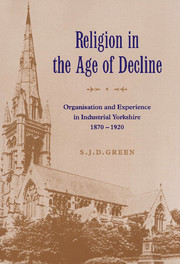Book contents
- Frontmatter
- Contents
- Acknowledgements
- List of tables
- List of abbreviations
- Introduction
- Part I Providing the means
- Part II Drawing in the people
- Part III The trials of the religious life
- 7 Worship exalted and experience eclipsed: liturgical orderliness, dutiful observance and the making of a modern Christian witness
- 8 Christianity within and beyond the churches: the pattern of the devotion and the authenticity of expression
- 9 The forward march of the Christian churches halted? Organisational stasis and the crisis of the associational ideal in early twentieth-century religious institutions
- Conclusion
- Bibliography
- Index
9 - The forward march of the Christian churches halted? Organisational stasis and the crisis of the associational ideal in early twentieth-century religious institutions
from Part III - The trials of the religious life
Published online by Cambridge University Press: 08 October 2009
- Frontmatter
- Contents
- Acknowledgements
- List of tables
- List of abbreviations
- Introduction
- Part I Providing the means
- Part II Drawing in the people
- Part III The trials of the religious life
- 7 Worship exalted and experience eclipsed: liturgical orderliness, dutiful observance and the making of a modern Christian witness
- 8 Christianity within and beyond the churches: the pattern of the devotion and the authenticity of expression
- 9 The forward march of the Christian churches halted? Organisational stasis and the crisis of the associational ideal in early twentieth-century religious institutions
- Conclusion
- Bibliography
- Index
Summary
Introduction: an emerging sense of failure
When it considered the vital questions of organisational advance and decline – or of spiritual gain and loss – in the years leading up to the outbreak of the First World War, informed local opinion invariably arrived at depressing conclusions. Pastors and priests, whether Anglican, Roman Catholic or dissenter, counted more churches than ever. But Catholics aside, they saw fewer people in them. Churchmen, ministers and laymen presided over more complex religious institutions. Yet these organisations attracted fewer regular members than they had hoped for. Teachers and volunteers dedicated themselves to more sophisticated Sunday schools. However, they induced fewer of the young into the life of religion than their best efforts warranted. Edwardian churches and chapels organised more frequent religious missions and visitations than their mid-Victorian counterparts. Nevertheless, these efforts won fewer conversionary gains than expected. New and revived liturgies forged a quality of religious witness in public worship which was more solemn, more dignified and more reverential than that of old. Still, most informed locals doubted the evidence of real spiritual progress amongst their fellow worshippers. Uncertain of the commitment of those amongst their number, and fearing the worst of those beyond their walls, they began to envisage, with a barely concealed dread, the real possibility of a halt, that is, a permanent halt, to the forward march of the Christian churches.
- Type
- Chapter
- Information
- Religion in the Age of DeclineOrganisation and Experience in Industrial Yorkshire, 1870–1920, pp. 351 - 379Publisher: Cambridge University PressPrint publication year: 1996
- 2
- Cited by



